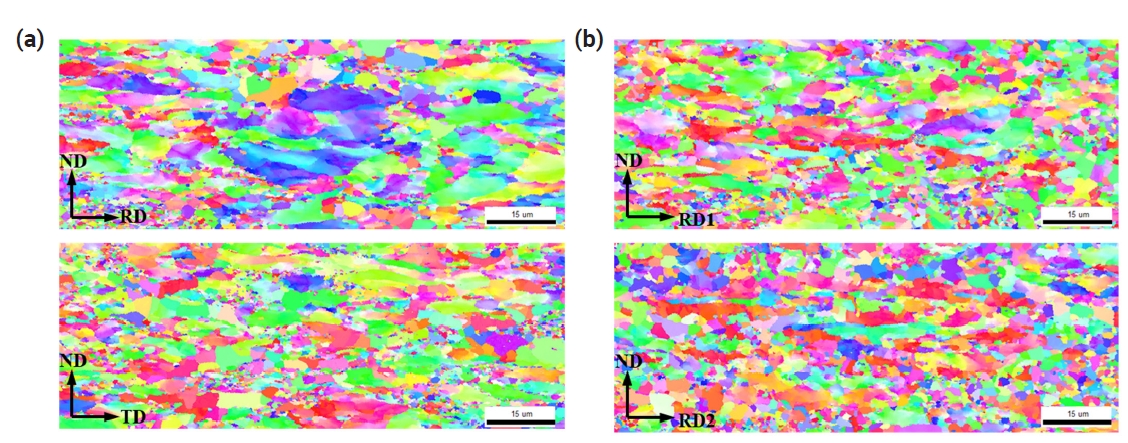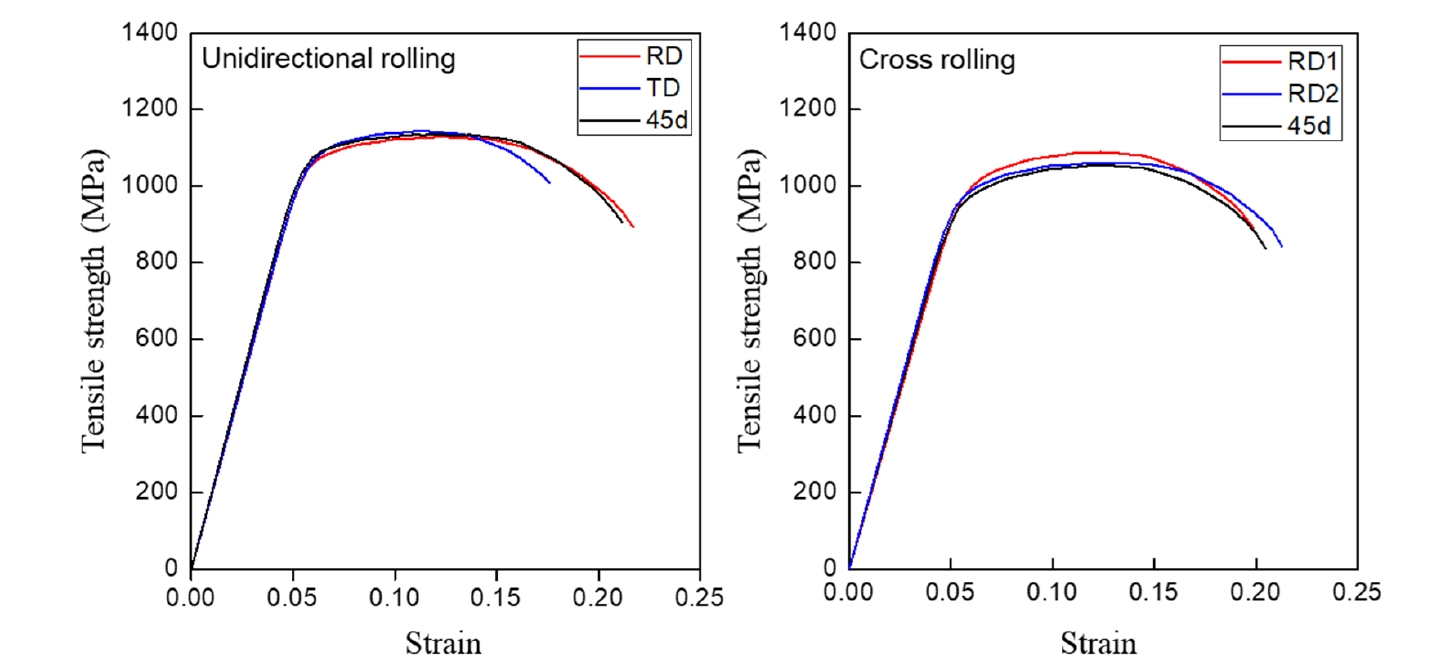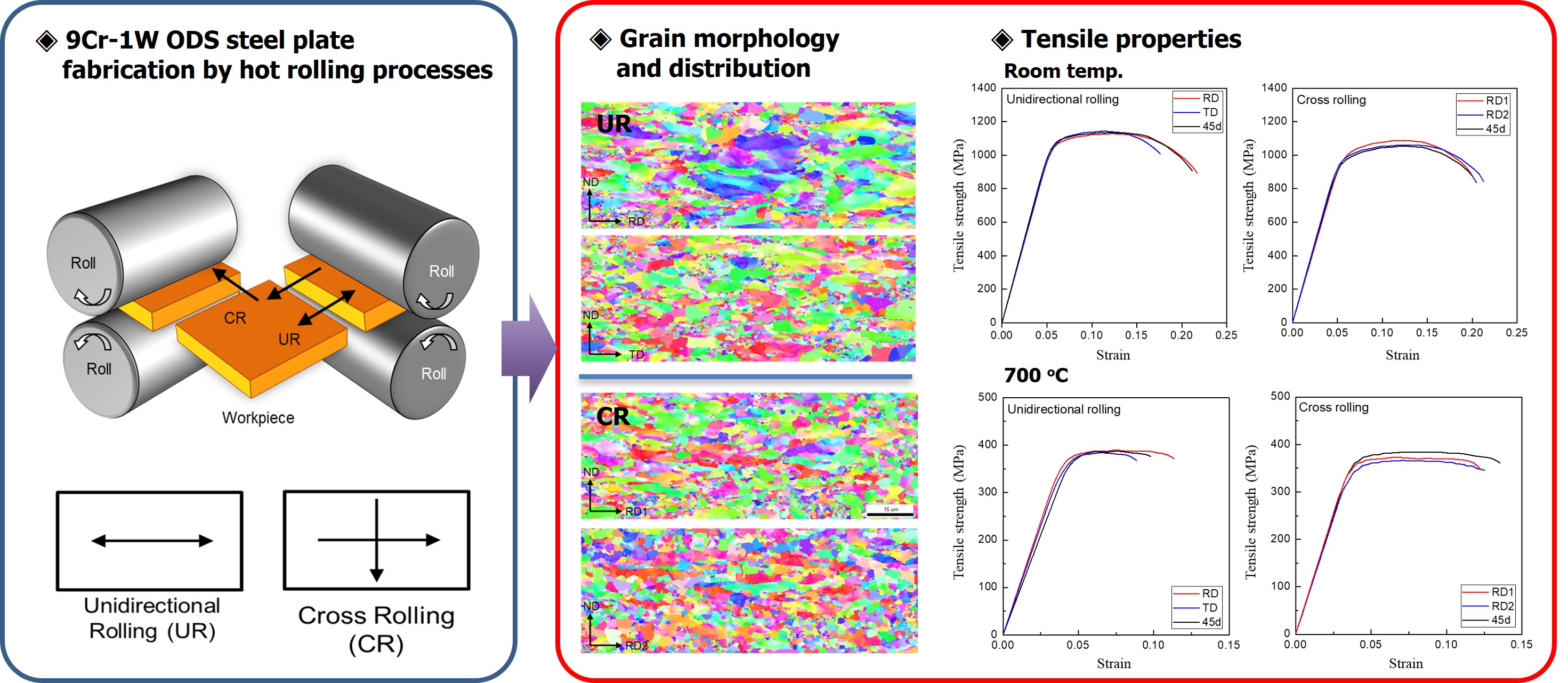Articles
- Page Path
- HOME > J Powder Mater > Volume 32(1); 2025 > Article
-
Research Article
- Effect of the Cross-rolling Process on the Microstructures and Mechanical Properties of 9Cr-1W ODS Steel
-
Bu-An Kim
 , Sanghoon Noh*
, Sanghoon Noh*
-
Journal of Powder Materials 2025;32(1):37-42.
DOI: https://doi.org/10.4150/jpm.2024.00332
Published online: February 28, 2025
Department of Materials Science and Engineering, Pukyong National University, Busan, 48513, Republic of Korea
- *Corresponding author: Sanghoon Noh E-mail: nohssang@pknu.ac.kr
© The Korean Powder Metallurgy & Materials Institute
This is an Open Access article distributed under the terms of the Creative Commons Attribution Non-Commercial License (http://creativecommons.org/licenses/by-nc/4.0/) which permits unrestricted non-commercial use, distribution, and reproduction in any medium, provided the original work is properly cited.
- 721 Views
- 23 Download
Abstract
- This study employed a cross-rolling process to fabricate oxide dispersion strengthened (ODS) steel plates and investigated their microstructures and mechanical properties. The 9Cr-1W ODS ferritic steel was fabricated using mechanical alloying and hot isostatic pressing. The hot cross-rolling process produced thick ODS ferritic steel plates with a well-extended rectangular shape. The working direction greatly affected the grain structure and crystal texture of the ODS ferritic steel. Cross-rolled plates showed fine micro-grains with random crystal orientation, while unidirectionally rolled plates exhibited a strong orientation with larger, elongated grains. Transmission electron microscopy revealed a uniform distribution of nano-oxide particles in both rolling methods, with no major differences. Tensile tests of the ODS ferritic steel plates showed that the unidirectional rolled plates had anisotropic elongation, while cross-rolled plates exhibited isotropic behavior with uniform elongation. Cross-rolling produced finer, more uniform grains, reducing anisotropy and improving mechanical properties, making it ideal for manufacturing wide ODS steel components.
- Next-generation nuclear reactors and fusion reactors are gaining attention as a new paradigm for energy production, with various research and development efforts underway internationally. Each of these nuclear and fusion reactors aims to provide a safer, more efficient, and lower-carbon method of energy production compared to traditional reactors. Notably, ITER (International Thermonuclear Experimental Reactor) is the world's largest nuclear fusion experiment, being conducted in France with collaboration between many countries. ITER aims to demonstrate that fusion energy is feasible on a large scale and is expected to begin experiments in the end-2020s. Beyond the realization of ITER, various design concepts have been proposed for demonstration and advanced fusion reactors. These concepts require more severe operational conditions than ITER. Many key components are fabricated to build advanced fusion reactors, with the blanket structure being one of the most important components. It functions for plasma confinement, tritium breeding, heat exchange, and shielding against severe thermo-neutron loads during repeated operation. It is mainly composed of first walls, side walls, a back board, and coolant channels. Advanced structural materials such as reduced-activation ferritic/martensitic (RAFM) steel, oxide dispersion strengthened (ODS) steel, and SiC composite are employed to fabricate the blanket structures [1-5]. ODS steel is one of the most promising structural materials for advanced fusion systems due to its excellent creep strength, corrosion resistance, and irradiation tolerance in nuclear/fusion environments [2-4, 6]. This is attributed to the uniformly distributed high-density nano-oxide particles, which are extremely stable at high temperatures within the ferritic/martensitic steel matrix. However, to employ ODS steels as structural materials, suitable fabrication technology development for components such as tubes, sheets, and plates is essential.
- There are several studies on the fabrication process for thin sheets and plates of ODS steels. Many researchers have described methods for fabricating ODS ferritic steel thin sheets and plates through hot rolling or a combination of hot rolling, cold rolling, and annealing. These studies found that the resulting thin sheets exhibit superior mechanical properties, including high strength, toughness, and ductility [7, 8]. They investigated the effect of hot rolling on the texture and microstructure of ODS steels and found that hot rolling can refine the grain size of ODS steels and improve their mechanical properties. Cross-rolling is a metal forming process that involves deforming a workpiece by rolling it at an angle to its previous rolling direction. This process is typically used to refine the grain structure and improve properties such as strength, toughness, and fatigue resistance. In cross-rolling, the workpiece is passed through rolls oriented at an angle, typically between 45 and 90 degrees, to the rolling direction. This change in rolling direction creates a more complex stress state, leading to grain refinement and improved mechanical properties.
- In this study, 9Cr-1W ODS ferritic steel plates with a rectangular shape were fabricated by mechanical alloying, hot isostatic pressing, and hot cross-rolling. After fabrication, the microstructures and mechanical properties were investigated and compared with unidirectional rolled plate.
1. Introduction
- 2.1 Material fabrication
- The ODS ferritic steels used in this study were Fe(bal.)-9Cr-1W-0.35Y2O3 in wt% with minor alloying elements including Ti, V, and Zr. The chemical composition was summarized in table 1. The ODS steels were fabricated by mechanical alloying (MA) and hot isostatic pressing (HIP) processes. Metallic raw powders and Y2O3 powder were mechanically alloyed by a horizontal ball-mill apparatus, ZOZ CM20. The MA atmosphere was thoroughly controlled in ultra-high purity argon (99.9999%) gas. The MA was performed for 40h with a ball-to-powder weight ratio of 10:1. High strength carbon steel balls were used as grinding media for MA process. Milled powders were then sieved and charged in a carbon steel capsule. All powder handling processes for the weighing, collecting, sieving, and charging were conducted in a completely controlled high purity argon atmosphere to prevent the oxygen contamination during the processes. Sealed capsules were then degassed at 400 °C below 5×10-4 torr for 3h. The HIP was carried out at 1150 °C for 4h at a heating rate of 5 °C/min and followed by furnace cooling. To fabricate the rectangular plate, HIPed ODS steels were rolled in two perpendicular directions after annealed at elevated temperature. This is well known as ‘cross-rolling’ which is a way to fabricate large rectangular shape in commercial steel production. In the cross-rolling process, it is very important to determine optimum rolling temperature, because ODS alloy normally has relatively high ductile-brittle transition temperature and quite high resistance for plastic deformation even in high temperature due to its stable oxide particles with a high number density. G. Zhang et al. investigated the hot deformation behavior and workability of 9Cr-2W ODS steel using constitutive equation and processing map. They reported that optimum hot working temprature was between 1080~1200 °C [9]. For favorable hot rolling condition without crack and working defect, HIPed ODS steels were annealed at 1100 °C for 1h in this study. The multistep cross-rolling was done, where a rolling direction is changed after each pass, and cross-rolling was carried out with a total thickness reduction ratio of about 65% with intermediete annealing at at 1100 °C for 10min. A schematic and outward appearance of hot rolled and peeled plates were shown in Fig. 1(a). A unidirectional rolling (UR) plate has elongated toward a rolling direction and no significant defect with favorable surface. A cross-rolled (CR) plate also has good external appearance condition with an extended rectangle shape.
- 2.2. Material characterization
- The grain morphology was observed by a FE-SEM and electron back-scattering diffraction (EBSD) analysis. Samples were mechanically wet grounded and finally polished with colloidal silica to remove the work-hardened surface induced by the mechanical grinding. An EBSD analysis was performed to estimate the crystallographic texture with an acceleration voltage of 20kV. The collected data was analyzed by TSL OIM® software. Precipitate distribution was also observed using carbon replica samples. A TEM observation was conducted using JEOL-2100FS electron microscopes with an acceleration voltage of 200kV. To evaluate the mechanical property of the plates, tensile specimens were machined with different directions, as shown in Fig. 1(b). The tensile properties were evaluated using a sheet-type miniaturized tensile specimen which measured 5 mm in gauge length, 1.2 mm in gauge width and 0.5 mm in thickness. Tensile tests were performed at room temperature, and 700 ºC with a strain rate of 6.7×10-4 s-1 in the air.
2. Experimental Section
- 3.1. Microstructures of hot-rolled ODS steel plates
- Different hot working directions significantly affect the grain morphologies and crystal texture of ODS ferritic steels. Inverse pole figure (IPF) maps of hot rolled ODS steel plates in different directions are shown in Fig. 2, where the horizontal direction corresponds to the hot rolling direction in both Fig. 2(a), (b). The IPF maps could be analyzed with colored triangle diagram and each color corresponded to each crystal orientation, where red, green and blue indicate (001), (101), (111), respectively. It could be seen that cross-rolled ODS steel plate with RD1, 2 in Fig. 2(b) and unidirectional rolled ODS steel plate with TD represented randomly crystal orientation including (001), (101), (111) without a preferred orientation. In contrast with this, unidirectional rolled ODS steel plate with RD showed high portion of blue region, corresponded to (111) orientation as shown in Fig. 2(a). The grain size distributions of ODS steel plates with different rolling processes were presented in Fig. 3. Typical anisotropic grain distribution was also given in UR plate, which has coarsened and elongated grains toward a rolling direction as shown. While, cross-rolled ODS steel plate with RD 1, 2 had similar grain distribution behavior. Estimated average grain sizes with different rolling directions were also could be distinguished as 3.26, 3.14 μm in cross-rolled ODS steel with RD 1, 2 and 4.91, 3.43 μm in unidirectional rolling with RD, TD, respectively. To investigate the effects of rolling directions on nano-meter scaled oxide particle distribution, a TEM observation was carried out. In Fig. 4, bright field images of ODS steel plates in different rolling directions, (a) UR, (b) CR are shown. It could be observed that nano-oxide particles are homogeneously distributed in all ODS steel plates. As shown in Fig. 4, there were no specific differences between two rolling processes.
- Through the observation of both hot rolled ODS steels, the cross-rolling could offer several features over conventional rolling processes including microstructural reduction of anisotropy and grain refinement without disruption of uniformly distributed nano-oxide particles.
- 3.2. Tensile property of hot-rolled ODS steel plates
- The Fig. 5 shows the stress-strain curves for unidirectional and cross rolled plates of the 9Cr-1W ODS ferritic steels after tensile tests at room temperature. There were no significant differences in yield, ultimate tensile strengths and uniform elongations in tensile directions between UR and CR plates of the ODS ferritic steels. The UR plate has favorable tensile properties, 1017~1025 MPa in yield strength, 1131~1143 MPa in ultimate tensile strength, and 11.9~12.3% in total elongation in room temperature. In different tension directions, UR plate showed an anisotropy that RD and 45° specimens in UR plate had better elongation than transverse direction (TD) specimen. It is well known that this anisotropic tension behavior is typical in UR plate for various thick metal plates. The CR plate also represented similar tensile behavior, which has slightly lower than those of UR plate, 889~945 MPa in yield strength, 1056~1088 MPa in ultimate tensile strength, and 12.6~12.7% in uniform elongation in room temperature. However, favorable isotropic behavior was shown in CR plate which had no significant difference in total elongation of 3 directional specimens. Therefore, it can be mentioned that CR process produces an ODS steel plate with more isotropic properties than UR process at room temperature. This provides some advantages to fabricate structural components through the plastic deformation process like a cold rolling, swaging, drawing at room temperature. Stress-strain curves for UR and CR plates of the 9Cr-1W ODS ferritic steels after tensile tests at elevated temperature, 700 °C in Fig. 6. Tensile behaviors of all tension directions between UR and CR plates were similar with those at room temperature. However, more exceptional isotropy of total elongation in CR plate was represented. The UR plate showed severe tensile anisotropy between 3 tension directions at 700 °C. In structural applications of ODS ferritic steels for blanket or divertor in fusion reactor, isotropic tension behavior is intensely important for component’s structural stability [1, 8]. Based on the experimental results, therefore it can be assured that cross-rolling process of ODS ferritic steels is very useful for fabrication method of wide and rectangular plate components which reduce anisotropy of ODS ferritic steels at both room and elevated temperatures. Additionally, the cross rolling of ODS ferritic steels offered several advantages over the uniaxially conventional rolling processes. The continuous change in rolling direction during cross rolling disrupted the existing grain structure homogenously, leading to the formation of finer grains. Fine and uniform grains generally result in improved tensile toughness and ductility in different tension direction at both room and elevated temperatures. Cross rolling of ODS ferritic steel could help to reduce the anisotropy of the material, which is the tendency for the material to have different properties in different directions. In UR process as shown in Fig. 2(a), a strong structure develops along the (111) direction. Hot cross rolling weakens this structure and distributes dislocations more evenly by introducing multidirectional strain as described in 2. experimental, dispersing dislocations more evenly. This is particularly important for applications where the material will be subjected to loads from multiple directions. It is considered that the cross rolling is widely used in the production of various ODS ferritic steel products including bars, rods, wires and seamless pipes. Especially, it could be employed in the piercing and rolling processes of seamless pipe manufacturing, resulting in pipes with enhanced mechanical properties and surface quality. Cross rolling is a versatile and effective metal forming process that offers significant improvements in the grain structure and mechanical properties of various steel products. Its ability to enhance strength, toughness, and dimensional accuracy makes it a valuable tool in the manufacturing industry.
3. Results and Discussion
- In this study, rectangular 9Cr-1W ODS ferritic steel plates were fabricated using hot unidirectional and cross rolling processes. And their microstructures and tensile properties were investigated. This study demonstrated that the multi-step cross-rolling process is an effective method for fabricating 9Cr-1W ODS ferritic steel plates with improved mechanical properties and isotropic behavior. The cross-rolling process produces finer, more uniform grains, reduces anisotropy, and maintains a homogeneous distribution of nano-oxide particles. Compared to unidirectional rolling, cross-rolled plates exhibit better isotropic properties, particularly in tensile behavior at both room and elevated temperatures. This is crucial for structural applications in fusion reactors, where materials must withstand multi-directional loads. The advantages of cross-rolling make it a promising technique for producing wide ODS steel components and seamless pipes with enhanced mechanical properties.
4. Conclusion
-
Funding
This work was supported by a Research Grant of Pukyong National University (2023).
-
Conflict of Interest
The authors have no conflicts of interest to declare.
-
Author Information and Contribution
Bu-An Kim: Professor; conceptualization, funding acquisition, methodology, writing–original draft Sanghoon Noh: Professor; supervision, experiment, writing–review & editing
-
Acknowledgments
None.
Article information






| Elements | Fe | C | Cr | W | Ti | V | Y | O |
|---|---|---|---|---|---|---|---|---|
| Compositions, wt.% | bal. | 0.07 | 8.85 | 1.2 | 0.27 | 0.19 | 0.28 | 0.22 |
- 1. Y. B. Chun, B. K. Choi, C. H. Han, D. W. Lee, S. Cho, T. K. Kim and Y. H. Jeong, In: Transactions of the Korean Nuclear Society Spring Meeting; Jeju, Korea. May 17-18; (2012) p. 478.
- 2. T. K. Kim, S. Noh, S. H. Kang, J. J. Park, H. J. Jin, M. K. Lee, J. Jang and C. K. Rhee: Nucl. Eng. Technol., 48 (2016) 572.Article
- 3. S. Ukai, T. Okuda, M. Fujiwara, T. Kobayashi, S. Mizuta and H. Nakashima: J. Nucl. Sci. Technol., 39 (2002) 872.Article
- 4. C. W. Park, J. Byun, J.K. Park and Y. D. Kim: J. Powder Mater., 23 (2016) 61.Article
- 5. T. Koyanagi, Y. Katoh, T. Nozawa, L. L. Snead, S. Kondo, C. H. Henager Jr, M. Ferrais, T. Hinoki and Q. Huang: J. Nucl. Mater., 511 (2018) 544.Article
- 6. Y.-K. Kim, J.-K. Park and K.-A. Lee: J Powder Mater., 25 (2018) 36.
- 7. J. Svoboda, V. Horník, L. Stratil, H. Hadraba, B. Mašek, O. Khalaj and H. Jirková: Metals, 8 (2018) 1079.Article
- 8. S. Zinkle, J. Boutard, D. Hoelzer, A. Kimura, R. Lindau, G. R. Odette, M. Rieth, L. Tan and H. Tanigawa: Nucl. Fusion, 57 (2017) 1.Article
- 9. G. Zhang, Z. Zhou, H. Sun, L. Zou, M. Wang and S. Li: J. Nucl. Mater., 455 (2014) 139.Article
References
Figure & Data
References
Citations

 ePub Link
ePub Link-
 Cite this Article
Cite this Article
- Cite this Article
-
- Close
- Download Citation
- Close
- Figure
- Related articles
-
- The Effect of Aluminum Powder Size on the Structure and Mechanical Properties of Foam
- Effect of Hatch Spacing on the Microstructure and Mechanical Properties of SA508 Gr.3 Steel Fabricated by Laser Powder Bed Fusion
- Effect of Sintering Conditions on the Microstructure of an FeCrMnNiCo High-Entropy Alloy
- Effect of Ball Milling Conditions on the Microstructure and Dehydrogenation Behavior of TiH2 Powder
- Effect of WC Particle Size on the Microstructure, Mechanical and Electrical Properties of Ag/WC Sintered Electrical Contact Material







Fig. 1.
Fig. 2.
Fig. 3.
Fig. 4.
Fig. 5.
Fig. 6.
Graphical abstract
| Elements | Fe | C | Cr | W | Ti | V | Y | O |
|---|---|---|---|---|---|---|---|---|
| Compositions, wt.% | bal. | 0.07 | 8.85 | 1.2 | 0.27 | 0.19 | 0.28 | 0.22 |
Table 1.
TOP
 KPMI
KPMI










